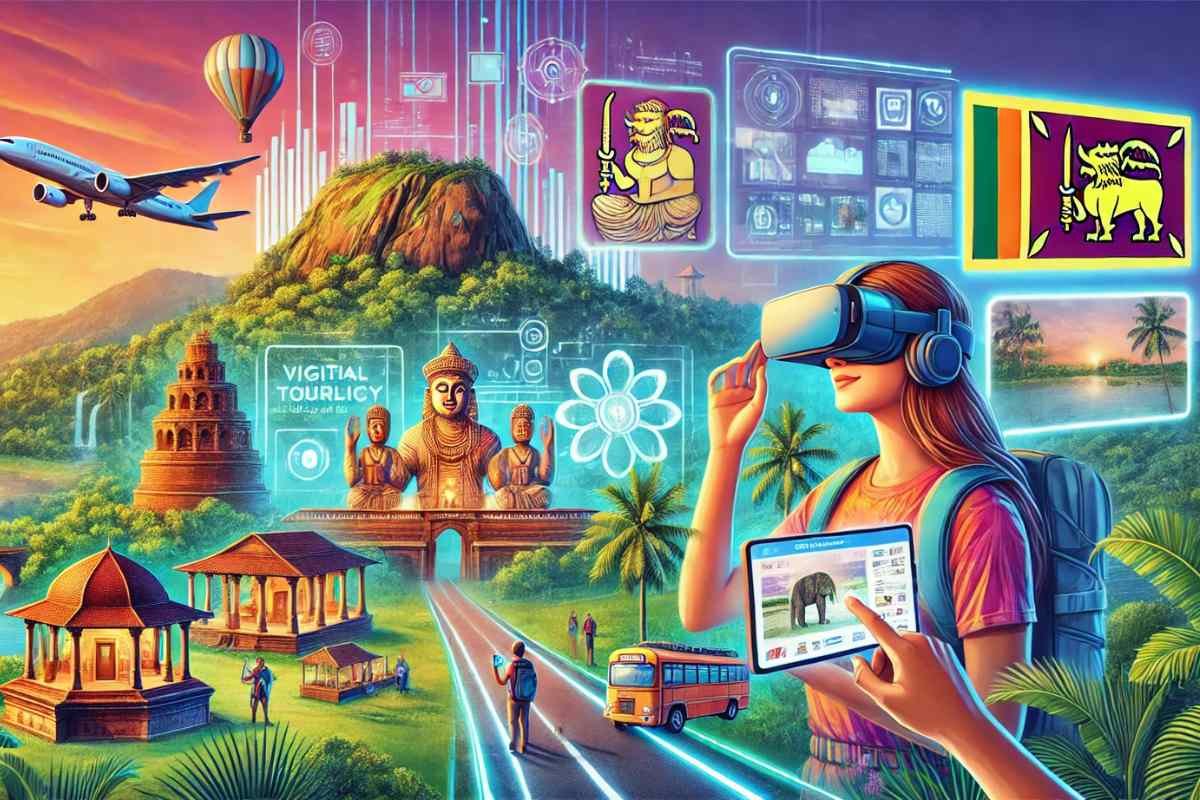
Sri Lanka betritt eine neue Ära des digitalen Tourismus und nutzt fortschrittliche Frameworks und datengesteuerte Erkenntnisse, um die Art und Weise zu verändern, wie es mit Reisenden aus aller Welt interagiert. Dieser Übergang zu einer stärker digitalisierten Tourismusstrategie lässt sich von erfolgreichen internationalen Modellen wie dem Australian Tourism Data Warehouse inspirieren, konzentriert sich jedoch auf die einzigartigen Stärken des Landes und erweitert seine digitalen Fähigkeiten. In diesem Artikel untersuchen wir, wie Sri Lanka sein Tourismus-Ökosystem verbessern kann, indem es ein integriertes digitales Framework aufbaut, mit Regierung und Industrie zusammenarbeitet und Gemeinden einbezieht, um unvergessliche Besuchererlebnisse zu schaffen.
Aufbau eines robusten digitalen Rahmens für den Tourismus in Sri Lanka
Im Einklang mit modernen digitalen Rahmenbedingungen wie Australiens Tourismus-DatenlagerSri Lanka kann eine umfassende digitale Infrastruktur entwickeln, um tourismusbezogene Daten zu aggregieren und zu verbreiten. Dieses System könnte als zentrale Informationsquelle für Touristen, Reiseveranstalter und lokale Unternehmen dienen. Darüber hinaus könnte Sri Lankas Integration eines Satellitenkonto Tourismus (TSA) wäre von entscheidender Bedeutung, um die wirtschaftlichen Auswirkungen des Tourismus zu verfolgen und eine datengestützte Politikgestaltung zu unterstützen. Durch die Kenntnis detaillierter Besucherdemografien, Ausgabegewohnheiten und Reisetrends kann das Land Marketingkampagnen maßschneidern, Dienstleistungen verbessern und nachhaltiges Wachstum im Tourismussektor vorantreiben.
Verbesserung digitaler Kampagnen durch Provinz- und Abteilungspartnerschaften
Zusammenarbeit mit Provinz- und Divisionssekretariate und Gemeinderäte ist entscheidend, um die Reichweite und Wirkung digitaler Kampagnen zu maximieren. Jede Provinz und Region verfügt über einzigartige kulturelle, historische und natürliche Attraktionen, die durch gezielte digitale Kampagnen beworben werden können. Lokale Behörden und das zentrale Tourismusamt können maßgeschneiderte Marketingmaterialien entwickeln und diese digital und offline verteilen, indem sie Ressourcen und Daten teilen. Diese Art der Zusammenarbeit stärkt den lokalen Tourismus und ermöglicht es den Regionen, ihren besonderen Reiz hervorzuheben.
Stärkung der Zusammenarbeit mit Tourismusinformationszentren
Tourismusinformationszentren in ganz Sri Lanka sind für die Unterstützung und Orientierung der Touristen unverzichtbar. Durch die Verbesserung der digitalen Integration und eine enge Zusammenarbeit mit diesen Zentren kann das Tourismusamt sicherstellen, dass die Touristen genaue und aktuelle Informationen zu Attraktionen, Veranstaltungen und Dienstleistungen im ganzen Land erhalten. Ausgestattet mit Echtzeitdaten und digitalen Tools können diese Zentren personalisierte Empfehlungen abgeben, die die Besucher dazu ermutigen, weniger bekannte Reiseziele zu erkunden, ihre Aufenthalte zu verlängern und die lokale Wirtschaft anzukurbeln. Darüber hinaus könnte die Einbindung von ehrenamtlichen Senioren und Universitätsstudenten in diese Zentren wertvolle Unterstützung vor Ort bieten und den angebotenen Dienstleistungen eine freundliche, sachkundige Note verleihen und gleichzeitig das Besuchererlebnis bereichern.
Verbesserung der Flughafendienste für ein nahtloses Besuchererlebnis
Flughäfen sind oft die erste Anlaufstelle für Reisende. Integration digitaler Dienste an Flughäfen, wie Kioske mit Touristeninformationen, Reiseführern zu lokalen Sehenswürdigkeiten und Updates zur Bearbeitung von E-Visa, kann Sri Lanka ein einladenderes und informativeres Ankunftserlebnis schaffen. Die Zusammenarbeit mit den Flughafenbehörden könnte sich auf spezielle Lounges für Touristen, Werbedisplays für Reiseziele im ganzen Land und sogar intelligente digitale Kioske erstrecken, die Echtzeitinformationen und Unterstützung in mehreren Sprachen bieten.
Förderung der Zusammenarbeit mit Universitäten im Bereich Forschung und Innovation
Zusammenarbeit mit Universitäten kann Sri Lankas Tourismusbranche mit Spitzenforschung und Innovationen versorgen. Partnerschaften mit akademischen Einrichtungen können die Forschung zu Touristenverhalten, nachhaltigen Praktiken und digitalen Marketingstrategien unterstützen. Universitäten könnten ebenfalls einen Beitrag leisten, indem sie spezielle Programme zur Ausbildung von Studenten in Tourismusmanagement, digitalem Marketing und Datenanalyse entwickeln und so einen Talentpool schaffen, der den sich entwickelnden Bedürfnissen der Branche entspricht.
Die Tourismusbranche für ein zusammenhängendes Ökosystem einbinden
Die branchenweite Zusammenarbeit zwischen Hotels, Reiseveranstaltern und anderen Interessengruppen ist für ein kohärentes und nachhaltiges Tourismusökosystem von entscheidender Bedeutung. Tourismusunternehmen können durch den Austausch von Daten, Erkenntnissen und Ressourcen ein nahtloses Besuchererlebnis schaffen und wettbewerbsbedingte Herausforderungen vermeiden. Digitale Plattformen könnten regelmäßige Branchentreffen ermöglichen, kooperatives Marketing fördern und Werbemaßnahmen für Hochsaison und besondere Veranstaltungen synchronisieren.
Engagement der Gemeinschaft zur Erhaltung und Förderung der lokalen Kultur
Durch die Einbindung lokaler Gemeinschaften in Tourismusinitiativen wird sichergestellt, dass die Vorteile des Tourismus einer breiten Öffentlichkeit zugute kommen. Engagement für die Gemeinschaft trägt auch dazu bei, Sri Lankas reiches kulturelles Erbe zu bewahren, da lokale Handwerker, Künstler und Geschichtenerzähler die Traditionen des Landes für Besucher zum Leben erwecken. Die Einbindung der Gemeinden durch Schulungsprogramme, digitale Tools und die Finanzierung kleiner Unternehmen kann die Einheimischen dazu befähigen, aktive Teilnehmer der Tourismusbranche zu werden, was die Authentizität der Erlebnisse der Besucher steigert.
Social Media für gemeinsame Kampagnen nutzen
Soziale Medien ist zu einem wirkungsvollen Instrument geworden, um ein globales Publikum zu erreichen. Gemeinsame Social-Media-Kampagnen unter Beteiligung von Regierungsstellen, Tourismusunternehmen und lokalen Influencern können Sri Lankas Sichtbarkeit erhöhen. Diese Kampagnen könnten sich auf Themen wie Kulturerbe, Abenteuer, Ökotourismus oder kulinarische Erlebnisse konzentrieren und Storytelling einsetzen, um das Publikum zu fesseln und es zu ermutigen, die vielfältigen Attraktionen des Landes zu erkunden. Social Media kann auch eine interaktive Plattform bieten, auf der Touristen ihre Erfahrungen teilen und so das Markenimage Sri Lankas stärken.
Förderung von Veranstaltungen und Festivals zur kulturellen Teilhabe
Veranstaltungen und Festivals sind die Hauptattraktionen, die das ganze Jahr über Besucher anziehen. gezielte digitale WerbeaktionenSri Lanka kann seine kulturellen Festivals, Sportveranstaltungen und andere Veranstaltungen hervorheben und Touristen einladen, an diesen Erlebnissen teilzunehmen. In Zusammenarbeit mit lokalen Behörden und Veranstaltern kann das Tourismusamt digitale Plattformen nutzen, um bevorstehende Veranstaltungen bekannt zu machen, Ticketservices anzubieten und sogar Live-Streaming-Optionen für die virtuelle Teilnahme bereitzustellen. Durch die Erstellung digitaler Inhalte rund um diese Veranstaltungen kann Sri Lanka seine Reichweite vergrößern und das Interesse für zukünftige Besuche wecken.
Erhebungen zu Touristendaten: Identifizierung von High Yield Travelers (HYT)
Durch die Nutzung umfassender touristischer Datenerhebungen kann Sri Lankas Tourismusbranche sein wertvollstes Zielgruppensegment genau identifizieren und verstehen: High Yield Travelers (HYT). Dieses Segment besteht aus Touristen, die mehr ausgeben und nach erstklassigen, umfassenden Erlebnissen suchen, die erheblich zur Wirtschaft beitragen. Durch die Konzentration auf HYT kann die Branche Marketingstrategien und Dienstleistungen maßschneidern, die dieses hochwertige Publikum ansprechen, und so sicherstellen, dass ein nachhaltiges Tourismusmodell Qualität vor Quantität priorisiert. Durch datengesteuerte Erkenntnisse kann Sri Lanka gezielte Kampagnen entwickeln und Angebote verbessern, um diese anspruchsvollen Reisenden anzuziehen und zu halten.
Sri Lankas Tourismusbranche bietet sich eine bemerkenswerte Chance, die digitale Transformation für nachhaltiges Wachstum zu nutzen. Durch die Entwicklung eines integrierten digitalen Rahmens, die Zusammenarbeit mit lokalen und nationalen Interessenvertretern und die Einbindung von Gemeinden kann das Land ein florierendes Tourismus-Ökosystem schaffen, das sowohl Besuchern als auch Einheimischen einen Mehrwert bietet. Mit seinem Engagement für Innovation, Zusammenarbeit und Kulturerhalt ist Sri Lanka gut aufgestellt, um in eine neue Ära des digitalen Tourismus einzutreten, die Reisende weltweit begeistern wird.




